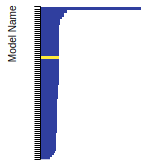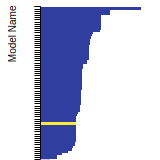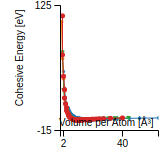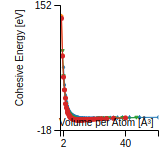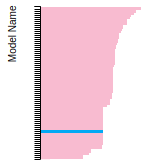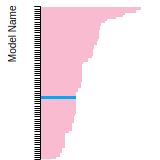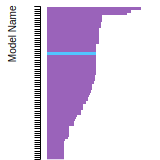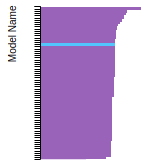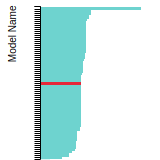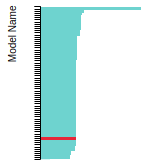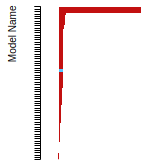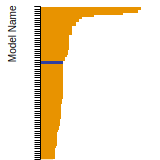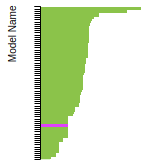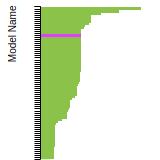 MEAM_LAMMPS_LeeWirthShim_2005_FeCu__MO_063626065437_002
MEAM_LAMMPS_LeeWirthShim_2005_FeCu__MO_063626065437_002
| Title
A single sentence description.
|
MEAM Potential for the Fe-Cu system developed by Lee et al. (2005) v002 |
|---|---|
| Description
A short description of the Model describing its key features including for example: type of model (pair potential, 3-body potential, EAM, etc.), modeled species (Ac, Ag, ..., Zr), intended purpose, origin, and so on.
|
A modified embedded-atom method (MEAM) interatomic potential for the Fe−Cu binary system has been developed using previously developed MEAM potentials of Fe and Cu. The Fe−Cu potential was determined by fitting to data on the mixing enthalpy and the composition dependencies of the lattice parameters in terminal solid solutions. The potential gives a value of 0.65eV for the dilute heat of solution and reproduces the increase of lattice parameter of Fe with addition of Cu in good agreement with experiments. The potential was used to investigate the primary irradiation defect formation in pure Fe and Fe−0.5at.%Cu alloy by a molecular dynamics cascade simulation study with a PKA energy of 2keV at 573K. In the paper (Lee et al., Phys. Rev. B, 2005), a tendency for self-interstitial atom-Cu binding, the formation of mixed (Fe−Cu) dumbbells and even Cu−Cu dumbbells was observed. |
| Species
The supported atomic species.
| Cu, Fe |
| Disclaimer
A statement of applicability provided by the contributor, informing users of the intended use of this KIM Item.
|
None |
| Content Origin | http://cmse.postech.ac.kr/home_2nnmeam |
| Contributor |
Jaemin Wang |
| Maintainer |
Jaemin Wang |
| Developer |
Byeong-Joo Lee Brian D. Wirth Jae-Hyeok Shim Junhyun Kwon Sang Chul Kwon Jun-Hwa Hong |
| Published on KIM | 2023 |
| How to Cite |
This Model originally published in [1] is archived in OpenKIM [2-5]. [1] Lee B-J, Wirth BD, Shim J-H, Kwon J, Kwon SC, Hong J-H. Modified embedded-atom method interatomic potential for the Fe- Cu alloy system and cascade simulations on pure Fe and Fe- Cu alloys. Physical Review B. 2005;71(18):184205. doi:10.1103/PhysRevB.71.184205 — (Primary Source) A primary source is a reference directly related to the item documenting its development, as opposed to other sources that are provided as background information. [2] Lee B-J, Wirth BD, Shim J-H, Kwon J, Kwon SC, Hong J-H. MEAM Potential for the Fe-Cu system developed by Lee et al. (2005) v002. OpenKIM; 2023. doi:10.25950/3a47c45a [3] Afshar Y, Hütter S, Rudd RE, Stukowski A, Tipton WW, Trinkle DR, et al. The modified embedded atom method (MEAM) potential v002. OpenKIM; 2023. doi:10.25950/ee5eba52 [4] Tadmor EB, Elliott RS, Sethna JP, Miller RE, Becker CA. The potential of atomistic simulations and the Knowledgebase of Interatomic Models. JOM. 2011;63(7):17. doi:10.1007/s11837-011-0102-6 [5] Elliott RS, Tadmor EB. Knowledgebase of Interatomic Models (KIM) Application Programming Interface (API). OpenKIM; 2011. doi:10.25950/ff8f563a Click here to download the above citation in BibTeX format. |
| Citations
This panel presents information regarding the papers that have cited the interatomic potential (IP) whose page you are on. The OpenKIM machine learning based Deep Citation framework is used to determine whether the citing article actually used the IP in computations (denoted by "USED") or only provides it as a background citation (denoted by "NOT USED"). For more details on Deep Citation and how to work with this panel, click the documentation link at the top of the panel. The word cloud to the right is generated from the abstracts of IP principle source(s) (given below in "How to Cite") and the citing articles that were determined to have used the IP in order to provide users with a quick sense of the types of physical phenomena to which this IP is applied. The bar chart shows the number of articles that cited the IP per year. Each bar is divided into green (articles that USED the IP) and blue (articles that did NOT USE the IP). Users are encouraged to correct Deep Citation errors in determination by clicking the speech icon next to a citing article and providing updated information. This will be integrated into the next Deep Citation learning cycle, which occurs on a regular basis. OpenKIM acknowledges the support of the Allen Institute for AI through the Semantic Scholar project for providing citation information and full text of articles when available, which are used to train the Deep Citation ML algorithm. |
This panel provides information on past usage of this interatomic potential (IP) powered by the OpenKIM Deep Citation framework. The word cloud indicates typical applications of the potential. The bar chart shows citations per year of this IP (bars are divided into articles that used the IP (green) and those that did not (blue)). The complete list of articles that cited this IP is provided below along with the Deep Citation determination on usage. See the Deep Citation documentation for more information. 
50 Citations (33 used)
Help us to determine which of the papers that cite this potential actually used it to perform calculations. If you know, click the .
USED (high confidence) H.-S. Do and B.-J. Lee, “Origin of radiation resistance in multi-principal element alloys,” Scientific Reports. 2018. link Times cited: 38 USED (high confidence) C. D. Cruz, P. Chantrenne, R. Veiga, M. Perez, and X. Kleber, “Modified embedded-atom method interatomic potential and interfacial thermal conductance of Si-Cu systems: A molecular dynamics study,” Journal of Applied Physics. 2013. link Times cited: 7 Abstract: Thermal contact conductance of metal-dielectric systems is a… read more USED (high confidence) H. Hou, R. Wang, J. Wang, X. Liu, G. Chen, and P. Huang, “An analytic bond-order potential for the Fe–Cu system,” Modelling and Simulation in Materials Science and Engineering. 2012. link Times cited: 5 Abstract: An angular-dependent analytic bond-order potential (ABOP) fo… read more USED (low confidence) C. Yang, Y.-chao Liang, L.-li Zhou, Z.-an Tian, Q. Chen, and Y. Mo, “Strengthening mechanism and plasticity deformation of crystalline/amorphous Cu3Fe/Fe3Cu nanolayered composite,” Physica B: Condensed Matter. 2023. link Times cited: 0 USED (low confidence) M. Muralles, J. T. Oh, and Z. Chen, “Modified embedded atom method interatomic potentials for the Fe-Al, Fe-Cu, Fe-Nb, Fe-W, and Co-Nb binary alloys,” Computational Materials Science. 2023. link Times cited: 0 USED (low confidence) D. Tramontina et al., “Probing radiation resistance in simulated metallic core–shell nanoparticles,” Computational Materials Science. 2023. link Times cited: 0 USED (low confidence) Z. Sharipov et al., “Simulation of the Interaction Processes between Copper Nanoclusters and Metal Targets with Pore-Type Defects,” Journal of Surface Investigation: X-ray, Synchrotron and Neutron Techniques. 2022. link Times cited: 0 USED (low confidence) Y. Deng et al., “Molecular dynamics simulation of the growth and diffusion mechanisms of Fe–Cu bimetallic nanoparticles,” Philosophical Magazine. 2022. link Times cited: 1 Abstract: ABSTRACT In accordance with the molecular dynamic simulation… read more USED (low confidence) Z. Aitken, V. Sorkin, Z. Yu, S. Chen, Z. Wu, and Y.-W. Zhang, “Modified embedded-atom method potentials for the plasticity and fracture behaviors of unary fcc metals,” Physical Review B. 2021. link Times cited: 5 USED (low confidence) J. Zhu, T. Zhang, Y. Yang, and C. Liu, “Phase field study of the copper precipitation in Fe-Cu alloy,” Acta Materialia. 2019. link Times cited: 33 USED (low confidence) X. Duan, B. He, M. Guo, Z. Liu, Y. Wen, and B. Shan, “Lattice inversion modified embedded atom method for FCC metals,” Computational Materials Science. 2018. link Times cited: 8 USED (low confidence) C.-jun Wu, B.-J. Lee, and X. Su, “Modified embedded-atom interatomic potential for Fe-Ni, Cr-Ni and Fe-Cr-Ni systems,” Calphad-computer Coupling of Phase Diagrams and Thermochemistry. 2017. link Times cited: 60 USED (low confidence) I. Hijazi and Y. H. Park, “Mixed intermetallic potentials for Fe-Cu compounds,” Molecular Simulation. 2016. link Times cited: 0 Abstract: Metastable Fe-Cu alloys are of considerable scientific inter… read more USED (low confidence) A. P. Moore, B. Beeler, C. Deo, M. Baskes, and M. Okuniewski, “Atomistic modeling of high temperature uranium–zirconium alloy structure and thermodynamics,” Journal of Nuclear Materials. 2015. link Times cited: 41 USED (low confidence) S. B. Luo, W. Wang, L. Li, Z. Xia, and B. Wei, “Dendritic Growth Characteristics of Cu-Rich Zone within Phase Separated Fe50Cu50 Alloy,” Materials Science Forum. 2015. link Times cited: 0 Abstract: The undercooled Fe50Cu50 alloy experiences a metastable liqu… read more USED (low confidence) X. Duan, B. Zhou, R. Chen, H. Zhou, Y. Wen, and B. Shan, “Development of lattice inversion modified embedded atom method and its applications,” Current Applied Physics. 2014. link Times cited: 11 USED (low confidence) T. Szykowny, T. Giętka, Ł. Romanowski, and M. Trepczyńska-Łent, “A Study of Effects of Precipitation Hardening of Low-Alloy Copper-Nickel Spheroidal Cast Iron,” Archives of Foundry Engineering. 2014. link Times cited: 5 Abstract: One type of spheroidal cast iron, with additions of 0.51% Cu… read more USED (low confidence) A. Oluwajobi and X. Chen, “Effects of interatomic potentials on the determination of the minimum depth of cut in nanomachining,” International Journal of Abrasive Technology. 2013. link Times cited: 4 Abstract: The minimum depth of cut (MDC) is a major limiting factor on… read more USED (low confidence) C. D. Cruz, P. Chantrenne, and X. Kleber, “Molecular Dynamics Simulations and Kapitza Conductance Prediction of Si/Au Systems Using the New Full 2NN MEAM Si/Au Cross-Potential,” Journal of Heat Transfer-transactions of The Asme. 2012. link Times cited: 10 Abstract: Superlattices made by superposing dielectric and metal nanol… read more USED (low confidence) B.-J. Lee, W. Ko, H.-K. Kim, and E.-H. Kim, “The modified embedded-atom method interatomic potentials and recent progress in atomistic simulations,” Calphad-computer Coupling of Phase Diagrams and Thermochemistry. 2010. link Times cited: 137 USED (low confidence) A. Oluwajobi and X. Chen, “The fundamentals of modelling abrasive machining using molecular dynamics,” International Journal of Abrasive Technology. 2010. link Times cited: 17 Abstract: The development of ultra-precision processes which can achie… read more USED (low confidence) H. Wang, J. Chang, and B. Wei, “Density and related thermophysical properties of metastable liquid Ni–Cu–Fe ternary alloys,” Physics Letters A. 2010. link Times cited: 11 USED (low confidence) Z. Chen, N. Kioussis, N. Ghoniem, and D. Seif, “Strain-field effects on the formation and migration energies of self interstitials in α -Fe from first principles,” Physical Review B. 2010. link Times cited: 47 Abstract: Ab initio electronic structure calculations are employed to … read more USED (low confidence) H. Wang and B. Wei, “Thermophysical properties and structure of stable and metastable liquid cobalt,” Physics Letters A. 2010. link Times cited: 7 USED (low confidence) Y.-M. Kim, N. Kim, and B.-J. Lee, “Atomistic Modeling of pure Mg and Mg―Al systems,” Calphad-computer Coupling of Phase Diagrams and Thermochemistry. 2009. link Times cited: 119 USED (low confidence) E.-H. Kim, Y.-H. Shin, and B.-J. Lee, “A modified embedded-atom method interatomic potential for Germanium,” Calphad-computer Coupling of Phase Diagrams and Thermochemistry. 2008. link Times cited: 86 USED (low confidence) J. Jang, B.-J. Lee, and J.-H. Hong, “Influence of Cu, Cr and C on the irradiation defect in Fe: A molecular dynamics simulation study,” Journal of Nuclear Materials. 2008. link Times cited: 14 USED (low confidence) Y. Kubota, R. Matsumoto, and M. Nakagaki, “Molecular Dynamics Analysis on Crack Growth Behavior in Single and Nano-Crystalline Fe by the Use of FS-2NNMEAM Hybrid Potential,” Key Engineering Materials. 2007. link Times cited: 2 Abstract: In recent years, nano-crystalline materials have attracted m… read more USED (low confidence) Y.-M. Kim, B.-J. Lee, and M. Baskes, “Modified embedded-atom method interatomic potentials for Ti and Zr,” Physical Review B. 2006. link Times cited: 193 Abstract: Semiempirical interatomic potentials for hcp elements, Ti an… read more USED (low confidence) M. Popova, Y. Shen, and T. Khraishi, “Atomistic simulation of dislocation interactions in a model crystal subjected to shear,” Molecular Simulation. 2005. link Times cited: 7 Abstract: The interaction of edge dislocations in a two-dimensional (2… read more USED (low confidence) Y.-M. Kim and B.-J. Lee, “A modified embedded-atom method interatomic potential for the Cu–Zr system,” Journal of Materials Research. 2004. link Times cited: 65 USED (low confidence) Y.-M. Kim, Y.-H. Shin, and B.-J. Lee, “Modified embedded-atom method interatomic potentials for pure Mn and the Fe–Mn system,” Acta Materialia. 2009. link Times cited: 64 USED (low confidence) J. Li, X. Dai, S. Liang, K. Tai, Y. Kong, and B. Liu, “Interatomic potentials of the binary transition metal systems and some applications in materials physics,” Physics Reports. 2008. link Times cited: 110 NOT USED (high confidence) Y. J. Shen, L. C. Liu, S. Mi, H. Gong, and S. F. Zhou, “Construction of an n-body Fe–Cu potential and its application in atomistic modeling of Fe–Cu solid solutions,” Journal of Applied Physics. 2020. link Times cited: 6 Abstract: By means of the embedded-atom method, a Fe–Cu potential has … read more NOT USED (high confidence) Y. Wang, J. Ding, Y. Chen, J. Zhao, and Y. Wang, “Three-dimensional phase field simulation of intragranular void formation and thermal conductivity in irradiated α-Fe,” Journal of Materials Science. 2018. link Times cited: 14 NOT USED (high confidence) J. B. N. Kengne, B. Fongang, and S. Zekeng, “Structural Properties of Fe/Cu Magnetic Multilayers: A Monte Carlo Approach,” SPIN. 2017. link Times cited: 0 Abstract: Using atomistic Monte Carlo simulations, we investigated the… read more NOT USED (high confidence) T. Okita, Y.-Y. Yang, J. Hirabayashi, M. Itakura, and K. Suzuki, “Effects of stacking fault energy on defect formation process in face-centered cubic metals,” Philosophical Magazine. 2016. link Times cited: 14 Abstract: To elucidate the effect of stacking fault energies (SFEs) on… read more NOT USED (high confidence) C. P. Chui, W. Liu, Y. Xu, and Y. Zhou, “Molecular Dynamics Simulation of Iron — A Review.” 2015. link Times cited: 3 Abstract: Molecular dynamics (MD) is a technique of atomistic simulati… read more NOT USED (high confidence) T. Ito, T. Arima, M. Himi, and H. Yugo, “Atomistic simulations on the interfacial interaction of metallic fuel and structural materials in SFRs - molecular dynamics model for Pu-Fe system,” Journal of Nuclear Science and Technology. 2013. link Times cited: 2 Abstract: Interaction between metallic fuel and steel structures is on… read more NOT USED (high confidence) A. Oluwajobi, “Molecular Dynamics Simulation of Nanoscale Machining.” 2012. link Times cited: 6 Abstract: Product miniaturization is a major motivation for the develo… read more NOT USED (high confidence) S. Ryu and W. Cai, “A gold–silicon potential fitted to the binary phase diagram,” Journal of Physics: Condensed Matter. 2010. link Times cited: 30 Abstract: We develop an empirical interatomic potential model for the … read more NOT USED (high confidence) S. Ryu, C. Weinberger, M. Baskes, and W. Cai, “Improved modified embedded-atom method potentials for gold and silicon,” Modelling and Simulation in Materials Science and Engineering. 2009. link Times cited: 47 Abstract: The modified embedded-atom method interatomic potentials for… read more NOT USED (high confidence) E. C. Do, Y.-H. Shin, and B.-J. Lee, “Atomistic modeling of III–V nitrides: modified embedded-atom method interatomic potentials for GaN, InN and Ga1−xInxN,” Journal of Physics: Condensed Matter. 2009. link Times cited: 26 Abstract: Modified embedded-atom method (MEAM) interatomic potentials … read more NOT USED (high confidence) H. Wang and B. Wei, “Thermophysical property of undercooled liquid binary alloy composed of metallic and semiconductor elements,” Journal of Physics D: Applied Physics. 2009. link Times cited: 6 Abstract: The thermophysical properties of the liquid Ni–Si binary all… read more NOT USED (high confidence) H. Wang and B. Wei, “Theoretical prediction and experimental evidence for thermodynamic properties of metastable liquid Fe–Cu–Mo ternary alloys,” Applied Physics Letters. 2008. link Times cited: 12 Abstract: The prediction of thermodynamic properties for metastable un… read more NOT USED (high confidence) H. P. Wang and B. Wei, “Experimental determination and molecular dynamics simulation of specific heat for high temperature undercooled liquid,” Philosophical Magazine Letters. 2008. link Times cited: 2 Abstract: The accurate data of specific heat are of great significance… read more NOT USED (high confidence) B.-J. Lee, J. Shim, and J. Kwon, “Effects of crystallographic structure and Cr on the rate of void nucleation in BCC Fe: An atomistic simulation study,” Metals and Materials International. 2008. link Times cited: 1 Abstract: Atomistic Monte Carlo simulations based on modified embedded… read more NOT USED (high confidence) J. S. Kim, Y. Koo, B.-J. Lee, and S. Lee, “The origin of (001) texture evolution in FePt thin films on amorphous substrates,” Journal of Applied Physics. 2006. link Times cited: 105 Abstract: A theoretical study has been performed to rationalize the st… read more NOT USED (high confidence) J.-S. Kim, Y. Koo, and B.-J. Lee, “Modified embedded-atom method interatomic potential for the Fe–Pt alloy system,” Journal of Materials Research. 2006. link Times cited: 36 Abstract: A semi-empirical interatomic potential formalism, the modifi… read more NOT USED (high confidence) N. Vuksic, “New Zirconium Hydrogen Second Nearest Neighbor Modified Embedded Atom Method (MEAM) Potential For Simulation of Stacking Fault Energy Along the < 011̄0 > Path Of The Hexagonal Closely Packed Lattice Basal Plane.” 2014. link Times cited: 0 Abstract: A new Modified Embedded Atom Method (MEAM) potential for zir… read more |
| Funding | Not available |
| Short KIM ID
The unique KIM identifier code.
| MO_063626065437_002 |
| Extended KIM ID
The long form of the KIM ID including a human readable prefix (100 characters max), two underscores, and the Short KIM ID. Extended KIM IDs can only contain alpha-numeric characters (letters and digits) and underscores and must begin with a letter.
| MEAM_LAMMPS_LeeWirthShim_2005_FeCu__MO_063626065437_002 |
| DOI |
10.25950/3a47c45a https://doi.org/10.25950/3a47c45a https://commons.datacite.org/doi.org/10.25950/3a47c45a |
| KIM Item Type
Specifies whether this is a Portable Model (software implementation of an interatomic model); Portable Model with parameter file (parameter file to be read in by a Model Driver); Model Driver (software implementation of an interatomic model that reads in parameters).
| Portable Model using Model Driver MEAM_LAMMPS__MD_249792265679_002 |
| Driver | MEAM_LAMMPS__MD_249792265679_002 |
| KIM API Version | 2.2 |
| Potential Type | meam |
| Previous Version | MEAM_LAMMPS_LeeWirthShim_2005_FeCu__MO_063626065437_001 |
| Grade | Name | Category | Brief Description | Full Results | Aux File(s) |
|---|---|---|---|---|---|
| P | vc-species-supported-as-stated | mandatory | The model supports all species it claims to support; see full description. |
Results | Files |
| P | vc-periodicity-support | mandatory | Periodic boundary conditions are handled correctly; see full description. |
Results | Files |
| P | vc-permutation-symmetry | mandatory | Total energy and forces are unchanged when swapping atoms of the same species; see full description. |
Results | Files |
| A | vc-forces-numerical-derivative | consistency | Forces computed by the model agree with numerical derivatives of the energy; see full description. |
Results | Files |
| F | vc-dimer-continuity-c1 | informational | The energy versus separation relation of a pair of atoms is C1 continuous (i.e. the function and its first derivative are continuous); see full description. |
Results | Files |
| P | vc-objectivity | informational | Total energy is unchanged and forces transform correctly under rigid-body translation and rotation; see full description. |
Results | Files |
| P | vc-inversion-symmetry | informational | Total energy is unchanged and forces change sign when inverting a configuration through the origin; see full description. |
Results | Files |
| P | vc-memory-leak | informational | The model code does not have memory leaks (i.e. it releases all allocated memory at the end); see full description. |
Results | Files |
| P | vc-thread-safe | mandatory | The model returns the same energy and forces when computed in serial and when using parallel threads for a set of configurations. Note that this is not a guarantee of thread safety; see full description. |
Results | Files |
| P | vc-unit-conversion | mandatory | The model is able to correctly convert its energy and/or forces to different unit sets; see full description. |
Results | Files |
BCC Lattice Constant
This bar chart plot shows the mono-atomic body-centered cubic (bcc) lattice constant predicted by the current model (shown in the unique color) compared with the predictions for all other models in the OpenKIM Repository that support the species. The vertical bars show the average and standard deviation (one sigma) bounds for all model predictions. Graphs are generated for each species supported by the model.
Cohesive Energy Graph
This graph shows the cohesive energy versus volume-per-atom for the current mode for four mono-atomic cubic phases (body-centered cubic (bcc), face-centered cubic (fcc), simple cubic (sc), and diamond). The curve with the lowest minimum is the ground state of the crystal if stable. (The crystal structure is enforced in these calculations, so the phase may not be stable.) Graphs are generated for each species supported by the model.
Diamond Lattice Constant
This bar chart plot shows the mono-atomic face-centered diamond lattice constant predicted by the current model (shown in the unique color) compared with the predictions for all other models in the OpenKIM Repository that support the species. The vertical bars show the average and standard deviation (one sigma) bounds for all model predictions. Graphs are generated for each species supported by the model.
Dislocation Core Energies
This graph shows the dislocation core energy of a cubic crystal at zero temperature and pressure for a specific set of dislocation core cutoff radii. After obtaining the total energy of the system from conjugate gradient minimizations, non-singular, isotropic and anisotropic elasticity are applied to obtain the dislocation core energy for each of these supercells with different dipole distances. Graphs are generated for each species supported by the model.
(No matching species)FCC Elastic Constants
This bar chart plot shows the mono-atomic face-centered cubic (fcc) elastic constants predicted by the current model (shown in blue) compared with the predictions for all other models in the OpenKIM Repository that support the species. The vertical bars show the average and standard deviation (one sigma) bounds for all model predictions. Graphs are generated for each species supported by the model.
FCC Lattice Constant
This bar chart plot shows the mono-atomic face-centered cubic (fcc) lattice constant predicted by the current model (shown in red) compared with the predictions for all other models in the OpenKIM Repository that support the species. The vertical bars show the average and standard deviation (one sigma) bounds for all model predictions. Graphs are generated for each species supported by the model.
FCC Stacking Fault Energies
This bar chart plot shows the intrinsic and extrinsic stacking fault energies as well as the unstable stacking and unstable twinning energies for face-centered cubic (fcc) predicted by the current model (shown in blue) compared with the predictions for all other models in the OpenKIM Repository that support the species. The vertical bars show the average and standard deviation (one sigma) bounds for all model predictions. Graphs are generated for each species supported by the model.
FCC Surface Energies
This bar chart plot shows the mono-atomic face-centered cubic (fcc) relaxed surface energies predicted by the current model (shown in blue) compared with the predictions for all other models in the OpenKIM Repository that support the species. The vertical bars show the average and standard deviation (one sigma) bounds for all model predictions. Graphs are generated for each species supported by the model.
SC Lattice Constant
This bar chart plot shows the mono-atomic simple cubic (sc) lattice constant predicted by the current model (shown in the unique color) compared with the predictions for all other models in the OpenKIM Repository that support the species. The vertical bars show the average and standard deviation (one sigma) bounds for all model predictions. Graphs are generated for each species supported by the model.
Cubic Crystal Basic Properties Table
Species: CuSpecies: Fe
Creators:
Contributor: karls
Publication Year: 2019
DOI: https://doi.org/10.25950/64cb38c5
This Test Driver uses LAMMPS to compute the cohesive energy of a given monoatomic cubic lattice (fcc, bcc, sc, or diamond) at a variety of lattice spacings. The lattice spacings range from a_min (=a_min_frac*a_0) to a_max (=a_max_frac*a_0) where a_0, a_min_frac, and a_max_frac are read from stdin (a_0 is typically approximately equal to the equilibrium lattice constant). The precise scaling and number of lattice spacings sampled between a_min and a_0 (a_0 and a_max) is specified by two additional parameters passed from stdin: N_lower and samplespacing_lower (N_upper and samplespacing_upper). Please see README.txt for further details.
| Test | Test Results | Link to Test Results page | Benchmark time
Usertime multiplied by the Whetstone Benchmark. This number can be used (approximately) to compare the performance of different models independently of the architecture on which the test was run.
Measured in Millions of Whetstone Instructions (MWI) |
|---|---|---|---|
| Cohesive energy versus lattice constant curve for bcc Cu v004 | view | 8922 | |
| Cohesive energy versus lattice constant curve for bcc Fe v004 | view | 9129 | |
| Cohesive energy versus lattice constant curve for diamond Cu v004 | view | 8514 | |
| Cohesive energy versus lattice constant curve for diamond Fe v004 | view | 9638 | |
| Cohesive energy versus lattice constant curve for fcc Cu v004 | view | 9055 | |
| Cohesive energy versus lattice constant curve for fcc Fe v004 | view | 9399 | |
| Cohesive energy versus lattice constant curve for sc Cu v004 | view | 9276 | |
| Cohesive energy versus lattice constant curve for sc Fe v004 | view | 8703 |
Creators: Junhao Li and Ellad Tadmor
Contributor: tadmor
Publication Year: 2019
DOI: https://doi.org/10.25950/5853fb8f
Computes the cubic elastic constants for some common crystal types (fcc, bcc, sc, diamond) by calculating the hessian of the energy density with respect to strain. An estimate of the error associated with the numerical differentiation performed is reported.
| Test | Test Results | Link to Test Results page | Benchmark time
Usertime multiplied by the Whetstone Benchmark. This number can be used (approximately) to compare the performance of different models independently of the architecture on which the test was run.
Measured in Millions of Whetstone Instructions (MWI) |
|---|---|---|---|
| Elastic constants for bcc Cu at zero temperature v006 | view | 24209 | |
| Elastic constants for bcc Fe at zero temperature v006 | view | 23552 | |
| Elastic constants for diamond Cu at zero temperature v001 | view | 39506 | |
| Elastic constants for fcc Cu at zero temperature v006 | view | 22209 | |
| Elastic constants for fcc Fe at zero temperature v006 | view | 35043 | |
| Elastic constants for sc Cu at zero temperature v006 | view | 34013 | |
| Elastic constants for sc Fe at zero temperature v006 | view | 24288 |
Creators:
Contributor: ilia
Publication Year: 2023
DOI: https://doi.org/10.25950/e8a7ed84
Computes the equilibrium crystal structure and energy for an arbitrary crystal at zero temperature and applied stress by performing symmetry-constrained relaxation. The crystal structure is specified using the AFLOW prototype designation. Multiple sets of free parameters corresponding to the crystal prototype may be specified as initial guesses for structure optimization. No guarantee is made regarding the stability of computed equilibria, nor that any are the ground state.
| Test | Test Results | Link to Test Results page | Benchmark time
Usertime multiplied by the Whetstone Benchmark. This number can be used (approximately) to compare the performance of different models independently of the architecture on which the test was run.
Measured in Millions of Whetstone Instructions (MWI) |
|---|---|---|---|
| Equilibrium crystal structure and energy for Cu in AFLOW crystal prototype A_cF4_225_a v001 | view | 65375 | |
| Equilibrium crystal structure and energy for Cu in AFLOW crystal prototype A_cI2_229_a v001 | view | 74504 |
Creators:
Contributor: ilia
Publication Year: 2025
DOI: https://doi.org/10.25950/866c7cfa
Computes the equilibrium crystal structure and energy for an arbitrary crystal at zero temperature and applied stress by performing symmetry-constrained relaxation. The crystal structure is specified using the AFLOW prototype designation. Multiple sets of free parameters corresponding to the crystal prototype may be specified as initial guesses for structure optimization. No guarantee is made regarding the stability of computed equilibria, nor that any are the ground state.
| Test | Test Results | Link to Test Results page | Benchmark time
Usertime multiplied by the Whetstone Benchmark. This number can be used (approximately) to compare the performance of different models independently of the architecture on which the test was run.
Measured in Millions of Whetstone Instructions (MWI) |
|---|---|---|---|
| Equilibrium crystal structure and energy for Fe in AFLOW crystal prototype A_cF4_225_a v003 | view | 476177 | |
| Equilibrium crystal structure and energy for Fe in AFLOW crystal prototype A_cI2_229_a v003 | view | 146432 | |
| Equilibrium crystal structure and energy for Fe in AFLOW crystal prototype A_hP2_194_c v003 | view | 142057 | |
| Equilibrium crystal structure and energy for Fe in AFLOW crystal prototype A_tP28_136_f2ij v003 | view | 548845 |
Creators:
Contributor: brunnels
Publication Year: 2022
DOI: https://doi.org/10.25950/2c59c9d6
Computes grain boundary energy for a range of tilt angles given a crystal structure, tilt axis, and material.
Creators: Daniel S. Karls and Junhao Li
Contributor: karls
Publication Year: 2019
DOI: https://doi.org/10.25950/2765e3bf
Equilibrium lattice constant and cohesive energy of a cubic lattice at zero temperature and pressure.
| Test | Test Results | Link to Test Results page | Benchmark time
Usertime multiplied by the Whetstone Benchmark. This number can be used (approximately) to compare the performance of different models independently of the architecture on which the test was run.
Measured in Millions of Whetstone Instructions (MWI) |
|---|---|---|---|
| Equilibrium zero-temperature lattice constant for bcc Cu v007 | view | 12830 | |
| Equilibrium zero-temperature lattice constant for bcc Fe v007 | view | 12055 | |
| Equilibrium zero-temperature lattice constant for diamond Cu v007 | view | 15387 | |
| Equilibrium zero-temperature lattice constant for diamond Fe v007 | view | 14135 | |
| Equilibrium zero-temperature lattice constant for fcc Cu v007 | view | 15575 | |
| Equilibrium zero-temperature lattice constant for fcc Fe v007 | view | 12000 | |
| Equilibrium zero-temperature lattice constant for sc Cu v007 | view | 12612 | |
| Equilibrium zero-temperature lattice constant for sc Fe v007 | view | 12621 |
Creators: Daniel S. Karls and Junhao Li
Contributor: karls
Publication Year: 2019
DOI: https://doi.org/10.25950/c339ca32
Calculates lattice constant of hexagonal bulk structures at zero temperature and pressure by using simplex minimization to minimize the potential energy.
| Test | Test Results | Link to Test Results page | Benchmark time
Usertime multiplied by the Whetstone Benchmark. This number can be used (approximately) to compare the performance of different models independently of the architecture on which the test was run.
Measured in Millions of Whetstone Instructions (MWI) |
|---|---|---|---|
| Equilibrium lattice constants for hcp Cu v005 | view | 160934 | |
| Equilibrium lattice constants for hcp Fe v005 | view | 149976 |
Creators: Mingjian Wen
Contributor: mjwen
Publication Year: 2019
DOI: https://doi.org/10.25950/fc69d82d
This Test Driver uses LAMMPS to compute the linear thermal expansion coefficient at a finite temperature under a given pressure for a cubic lattice (fcc, bcc, sc, diamond) of a single given species.
| Test | Test Results | Link to Test Results page | Benchmark time
Usertime multiplied by the Whetstone Benchmark. This number can be used (approximately) to compare the performance of different models independently of the architecture on which the test was run.
Measured in Millions of Whetstone Instructions (MWI) |
|---|---|---|---|
| Linear thermal expansion coefficient of fcc Cu at 293.15 K under a pressure of 0 MPa v001 | view | 33347327 |
Creators:
Contributor: mjwen
Publication Year: 2024
DOI: https://doi.org/10.25950/9d9822ec
This Test Driver uses LAMMPS to compute the linear thermal expansion coefficient at a finite temperature under a given pressure for a cubic lattice (fcc, bcc, sc, diamond) of a single given species.
| Test | Test Results | Link to Test Results page | Benchmark time
Usertime multiplied by the Whetstone Benchmark. This number can be used (approximately) to compare the performance of different models independently of the architecture on which the test was run.
Measured in Millions of Whetstone Instructions (MWI) |
|---|---|---|---|
| Linear thermal expansion coefficient of bcc Fe at 293.15 K under a pressure of 0 MPa v002 | view | 1970629 |
Creators: Matt Bierbaum
Contributor: mattbierbaum
Publication Year: 2019
DOI: https://doi.org/10.25950/64f4999b
Calculates the phonon dispersion relations for fcc lattices and records the results as curves.
| Test | Test Results | Link to Test Results page | Benchmark time
Usertime multiplied by the Whetstone Benchmark. This number can be used (approximately) to compare the performance of different models independently of the architecture on which the test was run.
Measured in Millions of Whetstone Instructions (MWI) |
|---|---|---|---|
| Phonon dispersion relations for fcc Cu v004 | view | 87494 |
Creators:
Contributor: SubrahmanyamPattamatta
Publication Year: 2019
DOI: https://doi.org/10.25950/b4cfaf9a
Intrinsic and extrinsic stacking fault energies, unstable stacking fault energy, unstable twinning energy, stacking fault energy as a function of fractional displacement, and gamma surface for a monoatomic FCC lattice at zero temperature and pressure.
| Test | Test Results | Link to Test Results page | Benchmark time
Usertime multiplied by the Whetstone Benchmark. This number can be used (approximately) to compare the performance of different models independently of the architecture on which the test was run.
Measured in Millions of Whetstone Instructions (MWI) |
|---|---|---|---|
| Stacking and twinning fault energies for fcc Cu v002 | view | 17679521 |
Creators: Matt Bierbaum
Contributor: mattbierbaum
Publication Year: 2019
DOI: https://doi.org/10.25950/6c43a4e6
Calculates the surface energy of several high symmetry surfaces and produces a broken-bond model fit. In latex form, the fit equations are given by:
E_{FCC} (\vec{n}) = p_1 (4 \left( |x+y| + |x-y| + |x+z| + |x-z| + |z+y| +|z-y|\right)) + p_2 (8 \left( |x| + |y| + |z|\right)) + p_3 (2 ( |x+ 2y + z| + |x+2y-z| + |x-2y + z| + |x-2y-z| + |2x+y+z| + |2x+y-z| +|2x-y+z| +|2x-y-z| +|x+y+2z| +|x+y-2z| +|x-y+2z| +|x-y-2z| ) + c
E_{BCC} (\vec{n}) = p_1 (6 \left( | x+y+z| + |x+y-z| + |-x+y-z| + |x-y+z| \right)) + p_2 (8 \left( |x| + |y| + |z|\right)) + p_3 (4 \left( |x+y| + |x-y| + |x+z| + |x-z| + |z+y| +|z-y|\right)) +c.
In Python, these two fits take the following form:
def BrokenBondFCC(params, index):
import numpy
x, y, z = index
x = x / numpy.sqrt(x**2.+y**2.+z**2.)
y = y / numpy.sqrt(x**2.+y**2.+z**2.)
z = z / numpy.sqrt(x**2.+y**2.+z**2.)
return params[0]*4* (abs(x+y) + abs(x-y) + abs(x+z) + abs(x-z) + abs(z+y) + abs(z-y)) + params[1]*8*(abs(x) + abs(y) + abs(z)) + params[2]*(abs(x+2*y+z) + abs(x+2*y-z) +abs(x-2*y+z) +abs(x-2*y-z) + abs(2*x+y+z) +abs(2*x+y-z) +abs(2*x-y+z) +abs(2*x-y-z) + abs(x+y+2*z) +abs(x+y-2*z) +abs(x-y+2*z) +abs(x-y-2*z))+params[3]
def BrokenBondBCC(params, x, y, z):
import numpy
x, y, z = index
x = x / numpy.sqrt(x**2.+y**2.+z**2.)
y = y / numpy.sqrt(x**2.+y**2.+z**2.)
z = z / numpy.sqrt(x**2.+y**2.+z**2.)
return params[0]*6*(abs(x+y+z) + abs(x-y-z) + abs(x-y+z) + abs(x+y-z)) + params[1]*8*(abs(x) + abs(y) + abs(z)) + params[2]*4* (abs(x+y) + abs(x-y) + abs(x+z) + abs(x-z) + abs(z+y) + abs(z-y)) + params[3]
| Test | Test Results | Link to Test Results page | Benchmark time
Usertime multiplied by the Whetstone Benchmark. This number can be used (approximately) to compare the performance of different models independently of the architecture on which the test was run.
Measured in Millions of Whetstone Instructions (MWI) |
|---|---|---|---|
| Broken-bond fit of high-symmetry surface energies in bcc Fe v004 | view | 72188 | |
| Broken-bond fit of high-symmetry surface energies in fcc Cu v004 | view | 93333 |
Creators:
Contributor: efuem
Publication Year: 2023
DOI: https://doi.org/10.25950/fca89cea
Computes the monovacancy formation energy and relaxation volume for cubic and hcp monoatomic crystals.
| Test | Test Results | Link to Test Results page | Benchmark time
Usertime multiplied by the Whetstone Benchmark. This number can be used (approximately) to compare the performance of different models independently of the architecture on which the test was run.
Measured in Millions of Whetstone Instructions (MWI) |
|---|---|---|---|
| Monovacancy formation energy and relaxation volume for bcc Fe | view | 367955 | |
| Monovacancy formation energy and relaxation volume for fcc Cu | view | 285574 |
Creators:
Contributor: efuem
Publication Year: 2023
DOI: https://doi.org/10.25950/c27ba3cd
Computes the monovacancy formation and migration energies for cubic and hcp monoatomic crystals.
| Test | Test Results | Link to Test Results page | Benchmark time
Usertime multiplied by the Whetstone Benchmark. This number can be used (approximately) to compare the performance of different models independently of the architecture on which the test was run.
Measured in Millions of Whetstone Instructions (MWI) |
|---|---|---|---|
| Vacancy formation and migration energy for bcc Fe | view | 2307046 | |
| Vacancy formation and migration energy for fcc Cu | view | 1746867 |
| Test | Error Categories | Link to Error page |
|---|---|---|
| Elastic constants for diamond Fe at zero temperature v001 | other | view |
ElasticConstantsHexagonal__TD_612503193866_004
| Test | Error Categories | Link to Error page |
|---|---|---|
| Elastic constants for hcp Cu at zero temperature v004 | other | view |
| Elastic constants for hcp Fe at zero temperature v004 | other | view |
EquilibriumCrystalStructure__TD_457028483760_003
| Test | Error Categories | Link to Error page |
|---|---|---|
| Equilibrium crystal structure and energy for Fe in AFLOW crystal prototype A_tP1_123_a v003 | other | view |
GrainBoundaryCubicCrystalSymmetricTiltRelaxedEnergyVsAngle__TD_410381120771_003
PhononDispersionCurve__TD_530195868545_004
| Test | Error Categories | Link to Error page |
|---|---|---|
| Phonon dispersion relations for fcc Cu v004 | other | view |
SurfaceEnergyCubicCrystalBrokenBondFit__TD_955413365818_004
| Test | Error Categories | Link to Error page |
|---|---|---|
| Broken-bond fit of high-symmetry surface energies in bcc Fe v004 | other | view |
| Broken-bond fit of high-symmetry surface energies in fcc Cu v004 | other | view |
| MEAM_LAMMPS_LeeWirthShim_2005_FeCu__MO_063626065437_002.txz | Tar+XZ | Linux and OS X archive |
| MEAM_LAMMPS_LeeWirthShim_2005_FeCu__MO_063626065437_002.zip | Zip | Windows archive |
This Model requires a Model Driver. Archives for the Model Driver MEAM_LAMMPS__MD_249792265679_002 appear below.
| MEAM_LAMMPS__MD_249792265679_002.txz | Tar+XZ | Linux and OS X archive |
| MEAM_LAMMPS__MD_249792265679_002.zip | Zip | Windows archive |
